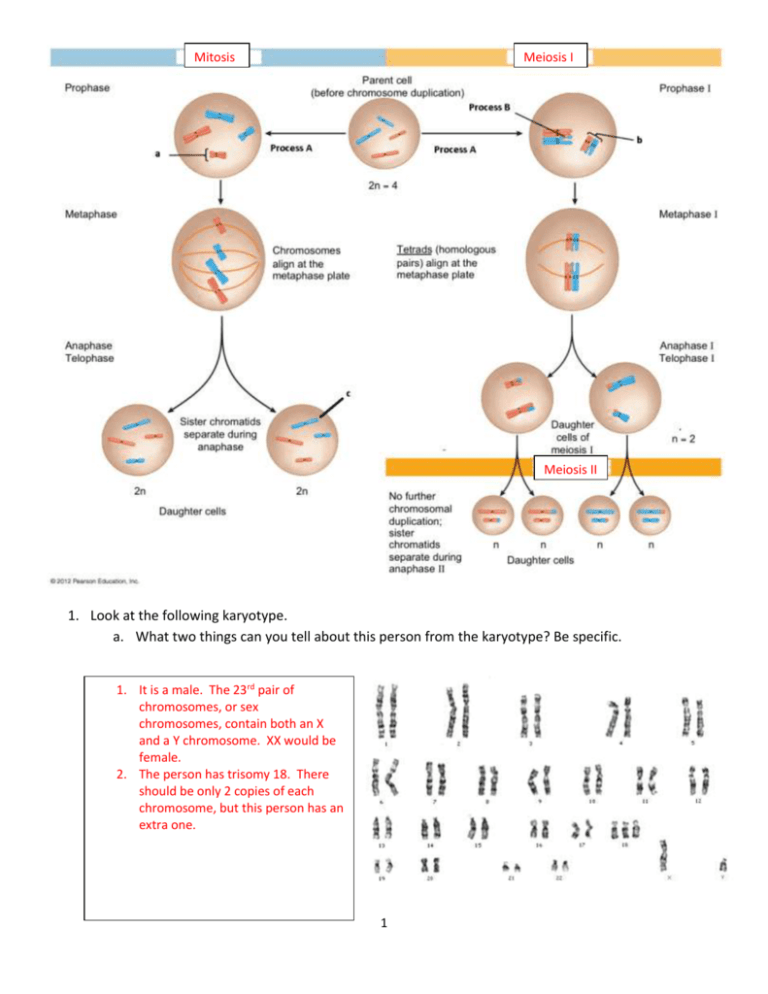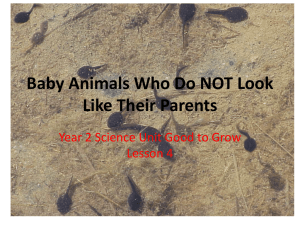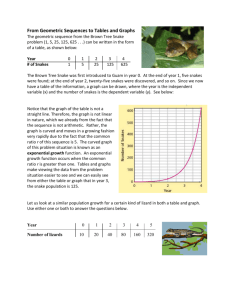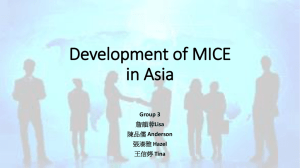Unit VII Genetics
advertisement

Mitosis Meiosis I Meiosis II 1. Look at the following karyotype. a. What two things can you tell about this person from the karyotype? Be specific. 1. It is a male. The 23rd pair of chromosomes, or sex chromosomes, contain both an X and a Y chromosome. XX would be female. 2. The person has trisomy 18. There should be only 2 copies of each chromosome, but this person has an extra one. 1 Unit VII Genetics Phenotype Genotype FF Ff Ff ff 1. Label columns 1 and 2 as genotype and phenotype. The write the letters that would represent each type in column 2. What two alleles are there for pea plant color? 2. Cross a heterozygous flowered pea plant with a white pea plant. Show all your work. Ffxff F f f Ff ff f Ff ff Genotypes-50% Ff, 50%ff Phenotypes- 50% purple, 50% white 3. Suppose a special pea plant produced lavender colored flower (blend of white and purple). What type of inheritance would this be showing? How would this change the above question? Incomplete dominance: pw x ww p w w pw ww w pw ww Genotypes-50% pw, 50%ww Phenotypes- 50% lavender, 50% white a. What about if the flowers were white with purple edges? Codominance Cocomplete dominance: PW x WW b. P W W PW WW W PW WW Genotypes-50% pw, 50%ww Phenotypes- 50% lavender, 50% white 2 4. List the genotypes and phenotypes for human blood typing. Genotype Phenotype A A A I I and I i Type A B B B I I and I i Type B A B II Type AB Ii Type O 5. Predict the phenotypes and genotypes of the offspring between a mom with type AB and a dad with type O. IAIB x ii Geno= 50% IAi, 50% IBi Pheno=50% A and 50% B i i IA IAi IAi IB IBi IBi 6. Hemophilia is sex linked. Predict the phenotypes and genotypes of the offspring between a heterozygous mom and a dad who has hemophilia. XHXh x XhY0 Genotype 25% XH Xh 25% Xh Xh 25% XH Y0 25% Xh Y0 Phenotype Female Normal Female Hemophiliac Male Normal Male Hemophiliac XH XH Xh XH Y 0 Xh Y0 Xh Xh Xh Xh Y 0 a. Who passes a sex-linked trait to males? Why? Female- they are the only one who can give the X to a male, the father gives a Y with no allele 7. What does it mean if a trait is considered polygenic? Give one example. It means the trait is controlled by multiple genes. This results in a wide range of phenotypes, such as height. 3 Unit VIII Evolution 1. Name and describe 3 different types of evidence that supports the theory of evolution. a. Fossil evidence- finding transitional fossils shows the link between extinct animals and modern animals b. Anatomical evidence- homologous structures, such as bat wings and rat arms, are evidence that those animals once shared a common ancestor c. DNA- DNA analysis shows how closely related some organisms are. Some genes are common throughout all animals 2. Suppose a population of mice was exposed to a new cat that had better camouflage. The mice cannot see the new cat very well, and therefore their numbers begin to decline. Over many generations, the mouse population begins to develop better eyesight, therefore they are able to recognize the cats better and escape. a. The mice are described as being a population. What does that mean in a biological sense and how is it different from being a species? A population is a group of the same species that live and interact together. Specifically, they can reproduce together, sharing genes. There can be multiple populations of the same species, which is all the animals that can successfully reproduce. b. Name and describe 2 adaptations mentioned above. Why are they adaptations? 1) Camouflage on the cat- helps them hide when hunting the mice. They get more mice, survive better and therefore have more offspring, increasing the beneficial gene 2) Mouse eyesight- they can see the cat better, therefore get eaten less. This means they have more offspring, passing down the good gene (adaptation) c. Describe the 4 steps of natural selection that must have occurred in the mouse population 1. Overproduction 2. Variation in population 3. Struggle for survival 4. Differential reproduction- better traits reproduce more d. What is the selective pressure in the scenario above? Predation 4 3. In a population of frogs there is variation in color. Some are lighter green, some are darker green, and some are brown. a. Read each scenario below and determine the type of microevolution that is occurring. Genetic drift (bottleneck effect) Gene flowimmigration Natural selection i. A disease spreads through the frog population, randomly killing frogs before they can reproduce. Slightly more brown frogs happen to be killed, reducing the frequency of the brown gene. ii. A boy coming back from vacation hundreds of miles away releases a few brown frogs into the population near his home. The brown allele has therefore become more frequent in the population. iii. Amongst the green grasses, the brown frogs are sticking out more. This allows raccoons to find the easier and therefore they are eaten more. The brown allele decreases in the population. 4. Differentiate microevolution and macroevolution. Microevolution - changes allele frequency - new species are not formed EvolutionChange in life through time Macroevolution - Speciationnew species are formed - Result of many microevolution events 5. New species form when populations of the same species become isolated, then change differently through time. Name and give examples for two ways a population can become isolated. a. Geographic isolation- population is separated by some physical boundary (canyon, deforestation, volcanic activity, etc. b. Reproductive isolation- groups in the same area do not reproduce, therefore separating their gene pools (Timing, behaviors, reproductive incompatibility,etc) 5 Unit IX Ecology 1. Use the following information about a community in a local ecosystem to create a food web. a. Snakes eat frogs and mice. Hawk b. Hawks eat snakes and squirrels. Foxes c. Mice eat grasses (seeds) Snakes d. Squirrels eat acorns (oak tree) Frogs e. Frogs eat pill bugs Mice Squirrel f. Pill bugs eat dead leaves (oak tree) g. Foxes eat mice and squirrels Pill Bugs Oak tree Grass 2. How does the 10% rule apply to the above food web? Oak and Grass get 100%=>pillbugs, mice and squirrels get 10%=>frogs snakes, and foxes get 1%, and the hawk gets 0.1% or 1%, depending on if it’s eating the snake or squirrel 3. The above items are all considered biotic. Why? They are all living a. Name 3 things that would be abiotic in the above ecosystem. Rocks, air, water 4. Give one example of each type of interspecies relationship: (many examples possible) a. Predation- snakes eating mice b. Symbiosis “Living together” i. Mutualism- Lichens; fungi get organic molecules form algae, which gets water and support from the fungi ii. Parasitism- Ticks sucking blood from deer, harming the deer iii. Commensalism- remora fish; eats scraps from shark’s meals, shark neither benefitted nor harmed. 5. Draw a simple carbon cycle diagram including: Autotrophs, heterotrophs, CO2, organic macromolecules, fossil fuels 6 7


![Historical_politcal_background_(intro)[1]](http://s2.studylib.net/store/data/005222460_1-479b8dcb7799e13bea2e28f4fa4bf82a-300x300.png)




